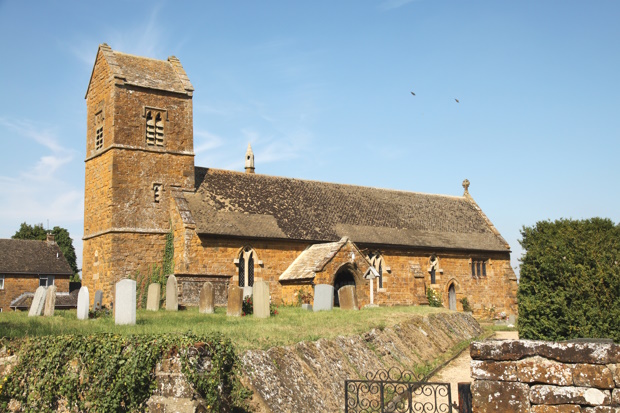


























The Church of St. James the Great, Claydon
The parish church of St. James the Great in Claydon is a small building of local stone consisting of nave, chancel, north aisle and chapel, west tower, and south porch. There is no division between nave and chancel. The nave and north aisle date from the late 12th century, and are separated by an arcade of three bays. The north chapel, lighted by lancet windows, was added during the early 13th century. The chancel was so much altered in the 19th century that the date of its original construction is now difficult to determine. The small west tower with its saddleback roof, unusual in Oxfordshire, was added in the 14th century. The subsequent history of the fabric was uneventful until 1860; only once, c. 1620, do 17thcentury churchwardens' presentments refer to the church being in need of attention, and Rawlinson c. 1718 thought it 'dark, but in tolerable repair'. The iron work on the main door into the nave bears the date 1640; some repairs were carried out in 1753 and 1795. By 1856, however, Bishop Wilberforce found the church 'in a wretched state internally—rather picturesque but pewed quite up to Communion rails and all sordid'. In 1860 an extensive restoration was begun. William White of Wimpole Street was the architect and Richard Wilson of Wardington the builder; except for the tower, the church was found to be in a much worse condition than had been thought, and was rebuilt on new foundations. The roof was reconstructed in oak, only a few of the old timbers being found fit for reuse; part of the north aisle was enlarged and rebuilt. The church was reseated and the accommodation was increased from 89 sittings (26 free) to 156 sittings (123 free). New windows were inserted in the chancel: that of three lights in the east wall by Wailes of Newcastle, and two in the south wall by Lavers and Baird (one a memorial to Mrs. Tait, the curate's widow). North Oxfordshire craftsmen executed the reredos of coloured alabaster, the pulpit, the sedilia of Caen stone, and the eagle lectern, altar (of oak), and carved oak font cover. The former three-legged wooden font was replaced by one of stone. The total cost was £542, raised by subscription. Wilberforce preached at the reopening in March 1861 and found the restoration 'very nicely done and the church very pretty'. After 1861 the only work recorded on the fabric was the repair of the chancel in 1922. During the incumbency of Francis Symes-Thompson (1907–11) an ambitious scheme of mural paintings (containing scenes from the life of St. James) in nave and sanctuary was attempted, but these were not thought satisfactory and were washed over. Other additions in the Tractarian tradition made by SymesThompson in 1908, apparently in advance of a faculty, remained in 1966, including the curtains round the altar, the small red marble table in the sanctuary, and a reproduction of Holman Hunt's picture 'The Light of the World'. Electric light was introduced in 1950; from 1957 the church was heated by electric heaters, which replaced a coke stove. The church contains mural tablets in memory of the Buswell family; there are several floor slabs to members of the Knibb family. An American harmonium (Story and Clark, Chicago) was installed in the 1890s, replacing a similar instrument. The church plate reflects the former poverty of the parish; it includes a pewter plate of c. 1749, a silver tankard flagon of 1832, presented to the church in 1839 in place of a pewter vessel, and a silver chalice and paten of 1855. According to Rawlinson, Claydon church pos sessed a peal of four bells; but in 1852, as in 1966, the peal was of three bells only. Two were cast in 1609 and 1611 and the tenor, originally cast in 1756, was recast in 1910 The clock, first mentioned in 1744, is a one-day hour-striking weight-driven mechanism of an early type, originally with a crown wheel and foliot escapement; it has no dial. It has been much repaired by local craftsmen: some time in the 18th century its mechanism was altered to an anchor escapement with a long pendulum. The clock ceased to function in 1859; after repair it was set going again on the ground floor of the tower in 1906. In 1910 Messrs. White provided it with steel ropes and increased its running time to 26 instead of 16 hours; it was repaired again in 1950. In the mid 18th century Claydon church was adorned with a painted sundial. The churchyard was enlarged on the south by the addition of 21 perches of glebe land (then a cottager's garden) given by the vicar in 1876; this may have been the site of the old parsonage-house. After 1945 the churchyard was further enlarged; in 1948 George Goode (d. 1949) by will left £100 for its upkeep. Within the churchyard stands a church room, built of ironstone, which was originally the Claydon day school; it bears the date 1840 on its east end. The registers date from the year 1569. They are not complete, the principal gap being in the marriage and burial registers between 1604 and 1634. Historical information about the Church of St. James the Great is provided by Christina Colvin, Janet Cooper, N H Cooper, P D A Harvey, Marjory Hollings, Judith Hook, Mary Jessup, Mary D Lobel, J F A Mason, B S Trinder and Hilary Turner, 'Parishes: Claydon', in A History of the County of Oxford: Volume 10, Banbury Hundred, ed. Alan Crossley (London, 1972), pp. 184-194. British History Online http://www.british-history.ac.uk/vch/oxon/vol10/pp184-194 [accessed 31 January 2023]. The Church of St. James the Great is a Grade II* listed building. For more information about the listing see CHURCH OF ST JAMES THE GREAT, Claydon with Clattercot - 1287785 | Historic England. For more information about the Church of St. James the Great see Parishes: Claydon | British History Online (british-history.ac.uk). |

